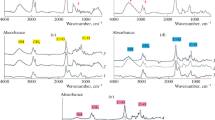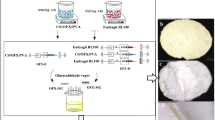Abstract
Age-related macular degeneration (AMD) is a degenerative ocular disease that affects the central retina. It is considered the main cause of blindness and loss of vision worldwide. Angiogenic factors are associated with AMD, which has led to the use of antiangiogenic drugs, such as bevacizumab, to treat the disease using frequent intravitreal injections. In the present study, biodegradable core shell nanofibers containing bevacizumab were prepared by the coaxial electrospinning technique. It is thought that the shell could control the release of the drug, while the core would protect and store the drug. Poly(caprolactone) (PCL) and gelatin were used to form the shell of the nanofibers, while poly(vinyl alcohol) (PVA) and bevacizumab comprised the core. The nanofibers were characterized using microscopy techniques, thermal analysis, and FTIR. The results showed that core-shell nanofibers were produced as designed. Bevacizumab activity was evaluated using a chicken embryo chorioallantoic membrane (CAM) assay. An enzyme-linked immunosorbent assay was used to quantify the amount of the drug released from the different nanofibers in vitro. The toxicity of the nanofibers was evaluated in human retinal pigment epithelial (ARPE) cells. The CAM results demonstrated that bevacizumab maintained its antiangiogenic activity when incorporated into the nanofibers. 3-(4,5-Dimethylthiazol-2-yl)-2,5-diphenyltetrazolium bromide (MTT) tests revealed that the nanofibers showed no cellular toxicity, even in the presence of bevacizumab. The core-shell structure of the nanofibers reduced the release rate of bevacizumab compared with PVA nanofibers. The bevacizumab-loaded biodegradable nanofibers presented interesting properties that would potentially constitute an alternative therapy to intravitreal injections to treat AMD.











Similar content being viewed by others
References
Inoue kh S. Genomic aspects of age-related macular degeneration. Biochem Biophys Res Commun. 2014;452:263–75.
Conley SM, Naash MI. Nanoparticles for retinal gene therapy. Prog Retin Eye Res. 2010;29:376–97.
Garg K, Bowlin GL. Electrospinning jets and nanofibrous structures. Biomicrofluidics. 2011;5:13403–22.
Júnior JA, Ávila AF, Triplett MH. Morphological characterization of polyamide-66 nanomembranes with graphene obtained by electrospinning. Polymer. 2013;23:74–81. https://doi.org/10.1590/S0104-14282012005000077
Jiang H, Wang L, Zhu K. Coaxial electrospinning for encapsulation and controlled release of fragile water-soluble bioactive agents. J Control Release. 2014;193:296–303.
Medeiros ES, Glenn GM, Klamczynski AP, Orts WJ, Mattoso LHC. Solution blow spinning: a new method to produce micro- and nanofibers from polymer solutions. J Appl Polym Sci. 2009;113:2322–30.
Greiner A, Wendorff JH, Yarin AL, Zussman E. Biohybrid nanosystems with polymer nanofibers and nanotubes. Appl Microbiol Biotechnol. 2010;71:387–93.
Islam MDS, Yeum JH. Electrospun pullulan/poly (vinyl alcohol)/silver hybrid nanofibers: preparation and property characterization for antibacterial activity. Colloids Surf A Physicochem Eng Asp. 2013;436:279–86.
Turaga U, Singh V, Behrens R, Korzeniewski C, Jinka S, Smith E, et al. Breathability of standalone poly (vinyl alcohol) nanofiber webs. Ind Eng Chem Res. 2014;53:6951–6958.
Spitzer MS, Wallenfels-Thilo B, Sierra A, Yoeruek E, Peters S, Henke-Fahle S, et al. Antiproliferative and cytotoxic properties of bevacizumab on different ocular cells. J Ophthalmol. 2006;90:316–1321.
Chagala Y, Altuzar V, Sarabia EL, Magaña JCT, Limón JMY, Barrera CM. Physicochemical properties of polycaprolactone/collagen/elastin nanofibers fabricated by electrospinning. Mater Sci Eng C. 2017;76:897–907.
Tian J, Yu W, Zhou C. The preparation and rheology characterization of long chain branching polypropylene. Polymer. 2006;47:7962–9. https://doi.org/10.1016/j.polymer.2006.09.042
Suárez I, García AS, Cabeza J, Capitán-Vallvey LF, Navas N. Development and use of specific ELISA methods for quantifying the biological activity of bevacizumab, cetuximab and trastuzumab in stability studies. J Chromatogr B. 2016;1032:155–64.
Nowak-Sliwinska P, Weiss A, van Beijnum JR, Wong TJ, Ballini JP, et al. Angiostatic kinase inhibitors to sustain photodynamic angio-occlusion. J Cell Mol Med. 2012;16:1553–62.
Gatnea DP, Mungekar S, Addepalli V, Mohanraj K, Sanjeevani A, Ghone SA, et al. Development of collateral vessels: a new paradigm in CAM angiogenesis model. Microvasc Res. 2016;16:11–13.
Acknowledgements
The authors acknowledge the financial support of CNPq, CAPES and FAPEMIG. This study is part of the National Institute of Science and Technology in Pharmaceutical Nanotechnology: a transdisciplinary approach INCT-NANOFARMA, which is supported by São Paulo Research Foundation (FAPESP, Brazil) Grant #2014/50928-2, and by “Conselho Nacional de Desenvolvimento Científico e Tecnológico” (CNPq, Brazil) Grant # 465687/2014-8.
Author information
Authors and Affiliations
Corresponding author
Ethics declarations
Conflict of interest
The authors declare that they have no conflict of interest.
Rights and permissions
About this article
Cite this article
de Souza, S.O.L., Guerra, M.C.A., Heneine, L.G.D. et al. Biodegradable core-shell electrospun nanofibers containing bevacizumab to treat age-related macular degeneration. J Mater Sci: Mater Med 29, 173 (2018). https://doi.org/10.1007/s10856-018-6187-5
Received:
Accepted:
Published:
DOI: https://doi.org/10.1007/s10856-018-6187-5




